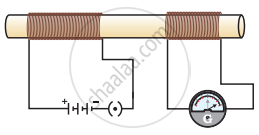Advertisements
Advertisements
प्रश्न
A coil is connected to a galvanometer. When the N-pole of magnet is pushed into the coil, the galvanometer deflected to the right. What deflection, if any, is observed when:
the N-pole is removed?
उत्तर
When the N-pole of a magnet is removed, deflection will take place in left direction because the induced current will flow in other direction.
APPEARS IN
संबंधित प्रश्न
The magnetic effect of current was discovered by:
(a) Maxwell
(b) Fleming
(c) Oersted
(d) Faraday
For the coil in the diagram below, when the switch is pressed:
(a) what is the polarity of end A?
(b) which way will the compass point then?

The north pole of a long bar magnet was pushed slowly into a short solenoid connected to a galvanometer. The magnet was held stationary for a few seconds with the north pole in the middle of the solenoid and then withdrawn rapidly. The maximum deflection of the galvanometer was observed when the magnet was ______.
A coil is connected to a galvanometer. When the N-pole of magnet is pushed into the coil, the galvanometer deflected to the right. What deflection, if any, is observed when:
the magnet is a rest in the coil?
If fuse of 250 mA, 500 mA, 1 A, 5 A and 10 A were available, which one would be the most suitable for protecting an amplifier rated at 240 V, 180 W?
A soft iron bar is introduced inside the current-carrying solenoid. The magnetic field inside the solenoid ____________.
In the arrangement shown in Figure there are two coils wound on a non-conducting cylindrical rod. Initially the key is not inserted. Then the key is inserted and later removed. Then

Paheli does not have a night lamp in her room. She covered the bulb of her room with a towel at the night to get dim light. Has she taken the right step? Give one reason to justify your answer.
An electric bell contains an ______, consisting of coils of insulated wire wound around
iron rods.
Make four electromagnets with 20, 40, 60 and 80 turns. Connect them one by one to a battery of 2 cells. Bring the electromagnet near a box of pins. Count the number of pins attracted by it. Compare the strengths of the electromagnets.
